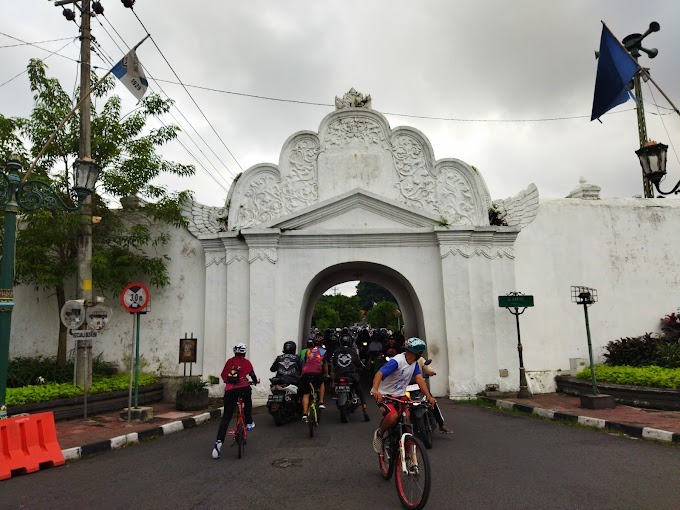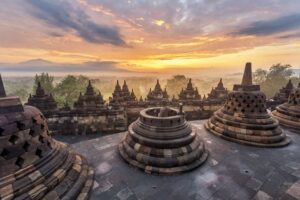The Yogyakarta History Tour Route is an adventure that will take you around various fascinating historical sites in this city. By following this route, you will be taken back to Yogyakarta’s glorious past and feel its historical charm.
1. Yogyakarta palace

Yogyakarta Palace, also known as Kraton Ngayogyakarta Hadiningrat, is a royal palace located in Yogyakarta, Indonesia. The following is a brief history of the Yogyakarta Palace:
The Yogyakarta Palace was founded in 1755 by Sultan Hamengkubuwono I after obtaining permission from Mataram, a kingdom based in Surakarta. Construction of this palace began as part of an agreement to support the Dutch in the Java War. One of the characteristics of the Yogyakarta Palace is its magnificent Javanese architecture. Designed with classic Javanese principles, the palace has beautiful buildings, gardens and well-maintained courtyards.
During its history, the Yogyakarta Palace has been the center of Javanese culture, arts and traditions. Cultural events and traditional ceremonies are often held here, including dance, gamelan and shadow puppet performances. The Yogyakarta Palace had an important role in Indonesia’s struggle for independence. In 1945, Sultan Hamengkubuwono IX declared the Palace’s support for Indonesian independence, which received widespread support from the public. Today, the Yogyakarta Palace is still inhabited by the royal family, who have a symbolic role in society. Tourism is also a source of income for the palace, with many visitors coming to explore its cultural and historical heritage. Yogyakarta Palace is one of the most important and iconic historical sites in Yogyakarta, reflecting the strength of Javanese culture and traditions. This palace plays a special role in Indonesian history and is still a vibrant cultural center today.
2. Plengkung Nirbaya Gate
Plengkung Nirbaya Gate is one of the iconic gates located in Yogyakarta, Indonesia. The following is a brief history of the Plengkung Nirbaya Gate:
This gate is known as the “Plengkung Nirbaya Gate” because it is located at the intersection between Jalan Plengkung Gading and Jalan Nirbaya. These two roads are the main roads in the area. Plengkung Nirbaya Gate is known for its unique and iconic design. This is a gate with a large arch that extends over the road. These arches are beautifully ornate and are often popular backdrops for photos. This gate was built in 2012 in an effort to beautify the appearance of the area and give an artistic impression to the main streets in Yogyakarta.
The Plengkung Nirbaya Gate has become an important local landmark. It is one of the locations frequently visited by visitors and locals to capture moments or simply enjoy its interesting architecture. This gate is also often the venue for various creative cultural activities such as art exhibitions, musical performances and other cultural events. This reflects the strong creative and artistic spirit present in Yogyakarta. The Plengkung Nirbaya Gate is an example of how art and design can influence the appearance of an area and give it a unique character. This gate is an important place in Yogyakarta culture and daily life.
3. Vredeburg Fort Museum

Vredeburg Museum, also known as Benteng Vredeburg, is a historical museum located in Yogyakarta, Indonesia. The following is a brief history of the Vredeburg Museum:
The name “Vredeburg” is Dutch and means “Fortress of Peace.” Initially, this building was a fort built by the Dutch colonial government in 1760. Vredeburg Fort was founded as part of the Dutch colonial defense system. It is part of the defense line surrounding Yogyakarta and is designed to protect the region from enemy attacks. During the Indonesian war of independence, this fort witnessed historic events. In 1949, when negotiations between the Netherlands and Indonesia for Indonesian independence took place, Fort Vredeburg was used as a place for negotiations, and the independence agreement was finally signed here on December 27, 1949.
After the independence agreement, this fort was then converted into a museum. The Vredeburg Museum is dedicated to commemorating the struggle of the Indonesian people to gain independence from Dutch colonialism. It became an independence museum featuring artifacts, historical documentation, and various exhibits depicting the national struggle. The Vredeburg Museum has a diverse collection, including weapons, historical photographs, documents and other historical artifacts detailing Indonesia’s struggle for independence. Exhibits inside the museum provide an in-depth insight into the history of Indonesian independence. The Vredeburg Museum is a historical symbol of Indonesia’s struggle for independence and the agreement that ended Dutch colonialism. This is an important place to understand Indonesian history and Yogyakarta’s role in the struggle for national independence. This museum is also a witness to important events in the history of the Indonesian nation.
4. Warungboto site

The Warungboto site, or also known as Bangsal Kencono, is a historical site located in Yogyakarta, Indonesia. The following is a brief history of the Warungboto Site:
Warungboto is part of the palace or palace complex used by the rulers of the Mataram Kingdom in the past. This palace was built by Sultan Hamengkubuwono I, founder of the Hamengkubuwono Dynasty, in the 18th century. The Warungboto site is famous for its exotic architectural design which mixes classical Javanese style with European architectural influences, especially neoclassical. The palace has a distinctive domed roof and beautiful buildings that reflect the splendor and power of the kingdom.
During its history, Warungboto was used for various royal activities, including receiving important guests, state ceremonies and diplomatic meetings. Bangsal Kencono is one of the main buildings in this palace complex. The Warungboto site also has an important role in Indonesian history. One of the historical moments was its use as a place for the signing of the Giyanti agreement in 1755, which ended the Puputan Mataram War between two Javanese royal families, Mataram and Surakarta. Today, the Warungboto Site is a popular tourism destination that attracts visitors with its unique architecture, beautiful gardens, and rich history. Several buildings within the complex have been converted into art galleries and museums showcasing Yogyakarta’s culture and history.
The Warungboto site is proof of Yogyakarta’s rich history and culture. This is a wonderful place to explore Javanese art, architecture and history while experiencing the grandeur of the kingdoms of the past.
5. Tamansari

Tamansari, also known as Taman Sari, is a historical site located in Yogyakarta, Indonesia. The following is a brief history of Tamansari: Construction of Tamansari began in the early 18th century by Sultan Hamengkubuwono I, founder of the Hamengkubuwono Dynasty in Yogyakarta. The main purpose of building Tamansari was to become a beautiful recreational palace complex. Tamansari was designed as a place of rest and recreation for the royal family and their followers. One of the main features is the beautiful water pools and buildings located in the middle of the pool.
Tamansari shows the influence of European architecture, especially in the use of water pools and the palace built in the center. These influences create a unique architectural style that is attractive to visitors. During its history, Tamansari was also an important place for royal events, including royal wedding ceremonies and traditional ceremonies. This place also has a secret room which was used for private royal meetings and conversations. Tamansari is also associated with the Diponegoro War (1825-1830), when the complex was used as a defensive fortification in the battle against Diponegoro rebels.
Today, Tamansari is one of the most popular tourism sites in Yogyakarta and has been recognized as a UNESCO World Heritage site. Visitors can explore the remaining buildings, pools and interesting underground chambers that are an important part of Yogyakarta’s history and culture. Tamansari is one of the most interesting and beautiful historical places in Yogyakarta, reflecting the rich history and culture of the kingdom’s past. This place is a silent witness to historical events and remains an attraction for tourists who want to experience the splendor of the Javanese kingdom.
The Yogyakarta History Tour Route is the perfect way to understand the city’s history, experience its charm and enjoy its rich cultural heritage. During the trip, you will be guided by a knowledgeable and passionate tour guide, who will ensure you gain a deep insight into Yogyakarta’s glorious past.





